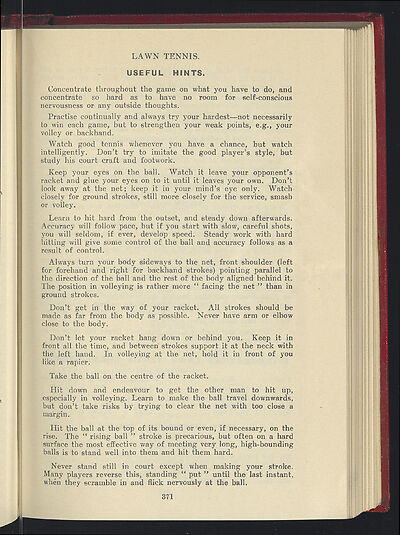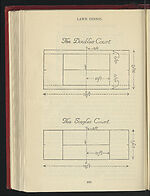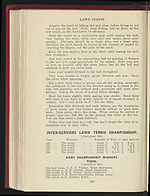1936-37
(393)
Download files
Complete book:
Individual page:
Thumbnail gallery: Grid view | List view

i
LAWN TENNIS.
USEFUL HINT'S.
Concentrate throughout the game on what you have to do, and
concentrate so hard as to have no room for self-conscious
nervousness or any outside thoughts.
Practise continually and always try your hardest—not necessarily
to win each game, but to strengthen your weak points, e.g., your
volley or backhand.
Watch good tennis whenever you have a chance, but watch
intelligently. Don't try to imitate the good player's style, but
study his court craft and footwork.
Keep your eyes on the ball. Watch it leave your opponent's
racket and glue your eyes on to it until it leaves your own. Don't
look away at the net; keep it in your mind's eye only. Watch
closely for ground strokes, still more closely for the service, smash
or volley.
Learn to hit hard from the outset, and steady down afterwards.
Accuracy will follow pace, but if you start with slow, careful shots,
you will seldom, if ever, develop speed. Steady work with hard
hitting will give some control of the ball and accuracy follows as a
result of control.
Always turn your body sideways to the net, front shoulder (left
for forehand and right for backhand strokes) pointing parallel to
the direction of the ball and the rest of the body aligned behind it.
The position in volleying is rather more " facing the net " than in
ground strokes.
Don't get in the way of your racket. All strokes should be
made as far from the body as passible. Never have arm or elbow
close to the body.
Don't let your racket hang down or behind you. Keep it in
front all the time, and between strokes support it at the neck with
the left hand. In volleying at the net, hold it in front of you
like a rapier.
Take the ball on the centre of the racket.
Hit down and endeavour to get the other man to hit up,
.especially in volleying. Learn to make the ball travel downwards,
but don't take risks by trying to clear the net with too close a
margin.
Hit the ball at the top of its bound or even, if necessary, on the
rise. The " rising ball " stroke is precarious, but often on a hard
surface the most effective way of meeting very long, high-bounding
balls is to stand well into them and hit them hard.
Never stand still in court except when making your stroke.
Many players reverse this, standing " put " until the last instant,
when they scramble in and flick nervously at the ball.
371
LAWN TENNIS.
USEFUL HINT'S.
Concentrate throughout the game on what you have to do, and
concentrate so hard as to have no room for self-conscious
nervousness or any outside thoughts.
Practise continually and always try your hardest—not necessarily
to win each game, but to strengthen your weak points, e.g., your
volley or backhand.
Watch good tennis whenever you have a chance, but watch
intelligently. Don't try to imitate the good player's style, but
study his court craft and footwork.
Keep your eyes on the ball. Watch it leave your opponent's
racket and glue your eyes on to it until it leaves your own. Don't
look away at the net; keep it in your mind's eye only. Watch
closely for ground strokes, still more closely for the service, smash
or volley.
Learn to hit hard from the outset, and steady down afterwards.
Accuracy will follow pace, but if you start with slow, careful shots,
you will seldom, if ever, develop speed. Steady work with hard
hitting will give some control of the ball and accuracy follows as a
result of control.
Always turn your body sideways to the net, front shoulder (left
for forehand and right for backhand strokes) pointing parallel to
the direction of the ball and the rest of the body aligned behind it.
The position in volleying is rather more " facing the net " than in
ground strokes.
Don't get in the way of your racket. All strokes should be
made as far from the body as passible. Never have arm or elbow
close to the body.
Don't let your racket hang down or behind you. Keep it in
front all the time, and between strokes support it at the neck with
the left hand. In volleying at the net, hold it in front of you
like a rapier.
Take the ball on the centre of the racket.
Hit down and endeavour to get the other man to hit up,
.especially in volleying. Learn to make the ball travel downwards,
but don't take risks by trying to clear the net with too close a
margin.
Hit the ball at the top of its bound or even, if necessary, on the
rise. The " rising ball " stroke is precarious, but often on a hard
surface the most effective way of meeting very long, high-bounding
balls is to stand well into them and hit them hard.
Never stand still in court except when making your stroke.
Many players reverse this, standing " put " until the last instant,
when they scramble in and flick nervously at the ball.
371
Set display mode to:
![]() Universal Viewer |
Universal Viewer | ![]() Mirador |
Large image | Transcription
Mirador |
Large image | Transcription
| Games and sports in the army > 1936-37 > (393) |
|---|
| Permanent URL | https://digital.nls.uk/248723047 |
|---|
| Description | 'Games and Sports in the Army' was an annual publication produced by the British War Office between the 1930s and 1960s. This included the Second World War. It outlines the rules and regulations for games and sports played by members of the armed forces. It features names and photographs of team members, and examples of contemporary advertising. |
|---|---|
| Shelfmark | GWB.52 |

